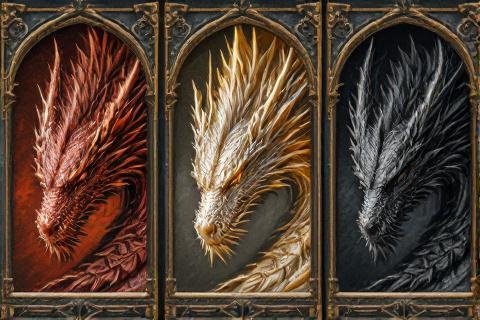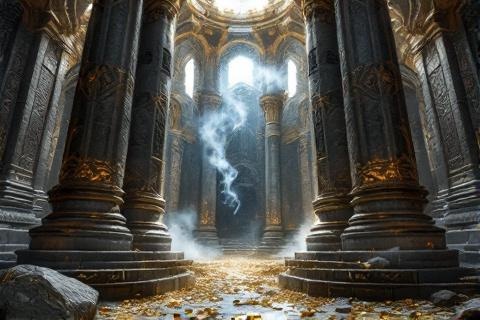
Smaug: The Last Great Dragon
The Terror Beneath the Mountain
The Last of the Great Dragons

Among the great wyrms of Middle-earth, Smaug stands as
one of the last and most formidable dragons of the Third
Age. By the time of his reign over the Lonely Mountain, most of
the great dragons of old had perished, making him a rare and terrifying remnant
of an earlier, more dangerous era.
While Smaug's might was considerable, he was preceded by even more terrible
dragons from the First Age. Glaurung,
the Father of Dragons, was Morgoth's first fire-drake and
wreaked havoc in the Battle of Sudden Flame and the Fall of Nargothrond.
Ancalagon the Black, greatest of all winged dragons, led Morgoth's aerial forces
in the War of Wrath until
Eärendil slew him in the greatest
dragon-slaying of all time.
Despite not matching the sheer might of his ancestors, Smaug earned his place in
history as the greatest fire-drake of the Third Age. His power was unmatched
among his contemporaries, and his name became synonymous with the very concept
of dragons in the northern regions of Middle-earth. No other dragon of his time
demonstrated such a combination of size, strength, cunning, and longevity.
Physical Appearance and Abilities
Smaug possessed truly immense proportions, with a massive wingspan that could
blot out the moon. His scales gleamed with a red-golden hue that marked him as
one of the great fire-drakes, and his physical presence was so overwhelming that
few could stand before him without being paralyzed by terror. The dragon's
serpentine form stretched hundreds of feet from snout to tail-tip, making him
one of the largest creatures still living in Middle-earth during the Third Age.
Through centuries of sleeping upon his stolen hoard, Smaug's underside became
encrusted with gems and gold pieces from Erebor's treasure,
forming an almost impenetrable armor. This natural protection, combined with his
inherently tough scales, made him virtually invulnerable to conventional
weapons. The dragon's acquisition of this armor showed his cunning nature, as he
deliberately used the treasure to reinforce his already formidable defenses.
The dragon possessed an array of devastating abilities that made him nearly
unstoppable in combat. His mastery of flight allowed him to strike with
incredible speed and precision from above, while his fire-breathing capabilities
were powerful enough to destroy the mighty gates of Erebor. Smaug's intelligence
surpassed that of most creatures, enabling him to plan complex strategies and
engage in sophisticated verbal exchanges.
Despite Smaug's seemingly invulnerable defenses, a single bare patch existed on
his left breast where a scale was missing. This vulnerable spot, approximately
the size of a thrush's egg, remained the dragon's only weakness. Bilbo
Baggins discovered this flaw during his burglary
attempt, though it was Bard the Bowman who ultimately exploited it with the
black arrow, guided by a thrush's message, to bring about Smaug's doom.
The Dragon's Lair

Erebor, the Lonely Mountain, stood as a solitary peak northeast of Mirkwood, its
distinctive silhouette visible for many leagues across the surrounding lands.
The mountain's location made it a natural fortress and landmark, rising in
solitary majesty above the plains and serving as the northernmost of the three
great kingdoms of the Dwarves east of the Misty Mountains.
Within the mountain lay an extraordinary network of halls, chambers, and
passageways crafted by generations of dwarven architects and craftsmen. The
Great Hall of Thráin, the Gallery of the Kings, and countless other magnificent
chambers showcased the pinnacle of dwarven craftsmanship. These halls contained
countless treasures: gold, gems, precious artifacts, and the renowned
Arkenstone, the Heart of the Mountain.
After seizing Erebor, Smaug modified the grand halls to suit his needs as a
lair. The dragon cleared the great chamber that would become his sleeping
quarters of all debris and smoothed the floors with his own movement over
decades. The once-bustling forges and workshops fell silent, and the grand
corridors that once echoed with dwarven activity became dark passages that
amplified the sound of his breathing throughout the mountain.
Intelligence and Cunning
Smaug's intelligence rivaled and often surpassed that of the wisest beings in
Middle-earth. He possessed not only cunning but also vast knowledge accumulated
over centuries, making him a formidable opponent in both physical and mental
confrontations. The dragon's wisdom extended beyond mere craftiness to include
an understanding of politics, history, and the nature of power that few
creatures could match.
The dragon demonstrated masterful command of the Common Speech, engaging in
complex wordplay and riddling conversations that showcased his verbal prowess.
His discussion with Bilbo Baggins revealed not only his gift for language but
also his ability to parse hidden meanings and detect subtle deceptions. Smaug's
facility with words made him particularly dangerous, as he could manipulate and
intimidate through conversation alone.
In his dealings with intruders and enemies, Smaug employed sophisticated
psychological warfare tactics. He understood how to use fear as a weapon,
combining physical threats with clever manipulation of his victims' minds. The
dragon could detect lies, analyze motivations, and exploit weaknesses in his
opponents' psyche, making him as dangerous in conversation as in combat.
The Desolation of Smaug

Smaug's assault on Erebor in T.A. 2770 demonstrated the full extent of his
destructive power. The dragon descended upon the mountain kingdom with fire and
fury, first attacking the city of Dale where he slew its lord, Girion. The
dragon's flames reduced the city to ash while its inhabitants fled in terror,
setting the stage for his assault on the mountain itself.
The aftermath of Smaug's attack reshaped the political and economic landscape of
northern Middle-earth. The surviving dwarves of Erebor became a wandering
people, while the descendants of Dale's population settled in Lake-town on the
Long Lake. The loss of both kingdoms created a power vacuum in the region that
would not be filled for many generations.
The area surrounding the Lonely Mountain became known as the Desolation of
Smaug, a wasteland where nothing grew and no creature dared to dwell. The
dragon's presence and the memory of his attack kept most travelers far from the
mountain's shadow. This barren landscape served as a constant reminder of the
dragon's terrible power and the consequences of drawing his attention.
The Dragon's Hoard

The treasure of Erebor that Smaug claimed represented wealth beyond counting,
accumulated through centuries of dwarven mining and craftsmanship. The vast
halls contained mountains of gold coins, precious gems, and priceless artifacts
that covered the floors of the great chamber where Smaug made his bed. This
hoard was considered one of the greatest concentrations of wealth in
Middle-earth during the Third Age.
Among the most notable items in Smaug's possession were pieces of exceptional
historical and cultural significance. These included the Arkenstone, the great
jewel of Thráin's house, as well as precious mithril mail, ancient weapons, and
jewelry of extraordinary craftsmanship. The collection included pieces dating
back to the First Age, making it not only valuable but historically priceless.
The treasure itself carried a subtle curse, often referred to as
dragon-sickness, which affected those who desired it too greatly. This malady of
the mind caused overwhelming greed and paranoia, symptoms that manifested
strongly in Thorin Oakenshield after
reclaiming the mountain. The curse was made worse by Smaug's long association
with the hoard, as dragons possessed the ability to enhance the corrupting
influence of treasure through their magic.
Legacy and Impact
Smaug's influence on the history of Middle-earth extended far beyond the
immediate impact of his attack on Erebor. His presence in the Lonely Mountain
affected trade routes, political alliances, and the balance of power throughout
the northern regions. The dragon's occupation of such a strategically important
location contributed to the weakening of the free peoples' defenses against the
growing shadow in the East.
The dragon's role in shaping the fate of the dwarves was particularly
significant. The loss of Erebor scattered the dwarves of Durin's
Folk across Middle-earth, leading to settlements in the Blue
Mountains and elsewhere. This diaspora changed the course of dwarven history and
ultimately led to the quest of Thorin Oakenshield,
which would have far-reaching consequences for all of Middle-earth.
Beyond the confines of Middle-earth, Smaug's character has become a defining
influence on modern interpretations of dragons in literature and popular
culture. His combination of physical might, intelligence, and personality helped
establish the archetype of the intelligent, speaking dragon that has influenced
countless stories since. Tolkien's detailed portrayal of Smaug set a new
standard for dragon characters in fantasy literature.
